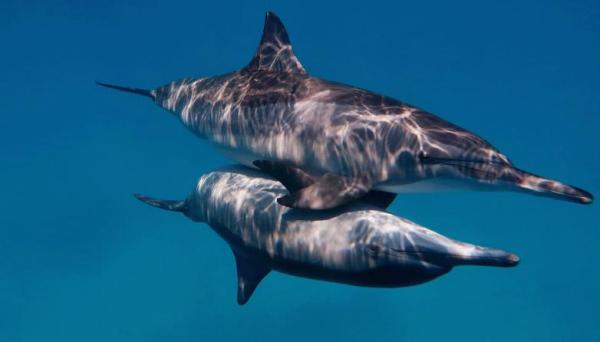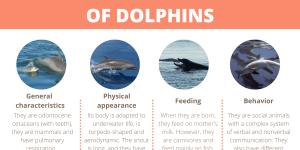Dolphin Mating and Reproduction


Dolphins are very social animals and are even considered friendly to humans. However, this can obscure the complexity of dolphin behavior. Their gregarious nature creates complex social dynamics in their pods. While they have the potential to be friendly, we should not consider them frivolous animals. They exhibit some of the greatest intelligence in all the animal kingdom and limiting their characteristics is to do them a disservice.
One of the most fascinating ways we can see this intelligence at work is when we look at dolphins mating. The structure and behaviors carried out during reproduction reveal how complex these aquatic mammals are. AnimalWised looks into dolphin mating and reproduction so you can see just why this is.
Dolphin characteristics
Before we explain specific behaviors linked to dolphins mating, we should provide some general background information. Dolphins are cetaceans, a type of mammal which was previously terrestrial, but then adapted to water via evolution. One aspect retained from their land walking heritage is their need to breathe air from the surface to intake oxygen. This is why it is common to see them swimming near the surface of the water.
There are many different species of dolphin which display various morphologies. The smallest dolphin is the Maui dolphin at 5 ft (1.5 m) long to the orca which has a maximum recorded size of 32 ft (9.8 m). All of them have a stylized body and an elongated snout, but other features vary. They have a blowhole on the top of their body, a kind of spiracle which allows them to breathe air from the surface.
Dolphins can live on their own, but the majority live in groups. The size can vary according to individual and species. In a group, each member has a role depending on their age, sex, time of reproduction, etc.
Among its main predators are sharks and other dolphins. For example, orcas (killer whales) regularly feed on other dolphins. However, one of the most important and immediate threats to dolphins is humans. They are victims of pollution, plastics, overfishing and other threats to their future.
How do dolphins reproduce?
To look at dolphins mating, we are going to focus mainly on bottlenose dolphins. These are perhaps the most famous and recognizable of all dolphin species, although this could be contended by orcas. Bottlenose dolphin mating is a mystery to most human beings, partly because it occurs underwater and is not regularly recorded. Despite this, the process is very similar to that of other mammals. Females have an ovulation period after which they mate with the male for fertilization. Once fertilized, the embryo begins to form within the womb and labor occurs once fully developed.
Bottlenose dolphins reach sexual maturity around the ages of 5 to 7 years. This varies according to species as some can take up to 13 years. Males become sexually mature before females. Overall life expectancy also depends on the species. Some can live up to 60 years, but bottlenose dolphins average between 30 and 40 years.
Since their life expectancy differs from species to species, it is normal for the time they reach sexual maturity to also vary. What is common to all species is, once sexual maturity is reached, dolphins will become very sexually active. This is especially the case for males.
How do dolphins mate?
Now we know when they become sexually mature, we can look at the process of dolphins mating more closely. Before allowing the male to approach, there is a necessary mating ritual. This ritual consists of the male performing different swimming movements around the female. At first glance, they may look like other underwater games. During the procession of this mating ritual, it is common for several males to compete for the same female. They may even attack each other to show which is strongest.
When the female dolphin eventually agrees to mate, she approaches with her genitals towards the chosen male. Female dolphins have a vagina and males have a penis and testicles. The female and male interlock with their bellies touching and fertilization can begin. While the male has to penetrate deep for fertilization, the whole process may only take a few seconds and require copulation to be repeated several times.
This is a type of internal fertilization which is carried out by all dolphins. Discover more about this subject as we explore external fertilization in animals.
When do dolphins reproduce?
Usually dolphins will mate during the warmer times of the year (spring/summer). They may migrate to warmer areas to reproduce. There is no single time or heat cycle for female dolphins. They can ovulate between two and seven times a year, depending on the species. They are seasonally polyestrous, meaning their reproductive season occurs between spring and autumn.
Do dolphins mate for fun?
Dolphins are polygamous and males can mate with several females in a single day. Additionally, they are one of the few non-human animals to have sex for pleasure. This means they have a kinds of dolphin intercourse which is not commonly observed in nature.
What kind of reproduction do dolphins have?
As we have already seen, dolphins take part in sexual reproduction. This means that dolphins reproduce by intercourse and fertilization. They are viviparous animals, as almost all mammals are, meaning they give birth to live offspring.

Dolphin gestation period
Once fertilization occurs, dolphins begin to develop inside their mother's womb. There they are surrounded in placenta and are connected by an umbilical cord. The gestation period of the dolphin is around 12 months, again with some variance according to species.
As with most female mammals, during pregnancy the female dolphin will tend to eat more food. This is both to ensure the proper development of the fetus and to ensure they can continued feeding after they have given birth. In some species, such as as the bottlenose dolphin, it has been observed that pregnant females will swim to warmer waters to give birth. A more temperate climate will help bolster chances of survival for their young.
It is difficult to monitor dolphin reproduction in the wild. While we know a little about some species such as bottlenose dolphins, it is still largely unknown if all dolphin mating occurs in the same way for each species.
How are dolphins born?
To know more about dolphin reproduction, we should look into how the animals are born. Unlike human beings, dolphins do not exit the womb headfirst. Instead, they emerge at the tail end, followed by the rest of the body. Once the baby has left the womb, the umbilical cord is broken and the baby rises to the surface (usually with the help of the mother) to take their first breath. This process usually takes around 40 to 60 minutes, although it may extend to three hours.
Since the female loses a lot of blood during labor, many predators can seize this moment to hunt her and her young. However, dolphins are one of the few non-human animals which enact attended births. When a dolphin is giving birth, other members of the pod place themselves around her for protection. During the labor process, one or more females may approach to verify everything is proceeding well.
How many babies can dolphins have?
Depending on the species, a dolphin will give birth to only one baby calf every 2-3 years. It is very rare for a dolphin to give birth to more than one dolphin calf at a time.
How big are dolphin calves at birth?
Depending on the species, at birth a dolphin can weigh up to 40 kg and measure between 3.2-5 ft (1-1.5 m). Once born, the dolphin goes through various stages of development, much of which has become a fascination for humans. More than dolphins mating, you can find out about these different life cycles below.
Birth of a dolphin video
Unfortunately, there is little footage of dolphins giving birth in the wild which exists. In the following video, you can see the birth of a dolphin calf in one of the Dolphin Quest enclosures:

How long do dolphins stay with their mother?
As with all mammals, their mothers have mammary glands, so calves feed on breast milk. In general, the lactation period of dolphins lasts between 12 and 24 months. Again, the length of breastfeeding time is species dependent. In the wild, researchers are still analyzing details related to dolphin lactation, making it difficult to create a general average for all dolphin species.
Generally, dolphin young will remain with their mother for a few more years after the period of breastfeeding has been completed. The average seems to be around 3 to 6 years in total. During this time, the offspring learn everything they can about social relationships, hunting methods, finding food and anything else they may need to be an adult dolphin. It is common for a dolphin mother to go away from their child for certain periods, leaving them in the care of other dolphins in the group. Gradually offspring are encouraged to become more independent.
We want to again emphasize that studies of dolphins in the wild are limited. Most dolphin studies have been carried out on captive specimens, the extent to which this affects their behavior, we do not know. This means it can be difficult to fully comprehend their true social relationships. Among the different dolphin species which exist, the bottlenose dolphin has been the most studied in the wild. However, there is still a lot to discover in terms of dolphin mating and reproduction.
What do dolphins eat?
Dolphin feeding depends on age. Newborn dolphins feed on breast milk. As with other mammals, the dolphin will wean the babies off of breast milk onto more solid food.
Once weaned, the dolphins will move on to an adult diet. Although for a long time it was a mystery, today we know that bottlenose dolphins have a daily diet of up to 5 kilograms of fish, squid, octopus, mollusks and other small marine animals. They do not chew their prey, but swallow them whole once they have them caught in their powerful jaws. To facilitate this process, they use the muscles at the back of their tongue and throat. These help them to either expel water or direct the fish to their stomach.
Among the many fascinating facts about dolphins, one of them has to do with the mechanism they use to catch their prey. Specifically, they use echolocation. This is a skill which works like a radar. They emit sounds and the reflection of these sounds helps them to locate fish, other dolphins, predators and many other stimuli in their environment.
Using echolocation, dolphins can observe the location of prey from great distances. When they attack, they do so as a group. Several individuals form a circle or semicircle which surrounds a school of fish, then they make their attack in turns, allowing each member to eat.
Learn more about the animals which use echolocation in our related guide.

Fascinating dolphin facts
Dolphins are fascinating animals which elicit much curiosity from humans. Here are some fascinating facts to pique this interest even further.
How do dolphins move?
Dolphins live in both freshwater and seawater, but generally prefer shallow waters nearer the shore. This is especially so in oceans where they prefer tropical and temperate climates. They don't like cold waters.
To move themselves away from these colder waters, they make long migrations, reaching speeds of up to 34 mph (54 km/h). Researchers believe it is not only warm temperatures they prefer, but the greater abundance of prey in the regions they go to.
How do dolphins sleep?
We would find it difficult to sleep in water without a support, especially when at the mercy of currents. Dolphins are able to do this without the aid of a flotation device via an ingenious method. They are able to turn half of their brain off to sleep, while the other half remains active and keeps the body afloat by kicking the tail back and forth.
The tail kicking keeps the dolphin's head and their blowhole out of the water. This allows for air to pass into the blowhole and keep the dolphin alive. Another curious fact is that there are recorded instances of dolphins committing suicide by going underneath the water and never returning to the surface.
Other facts about dolphins
Since these marine animals are so interesting, here are a few short facts to enjoy:
- They lack a sense of smell.
- They need to approach the surface every 10 minutes to breathe fresh air.
- They have a highly developed sense of hearing, can listen at great distances and even differentiate the sound of certain materials.
- They are collaborators with each other, live in groups and provide support when one of the members has been injured.
- They communicate through echolocation, dancing and jumping.
Learn more general information about how dolphins behave with our article detailing dolphin characteristics.
If you want to read similar articles to Dolphin Mating and Reproduction, we recommend you visit our Facts about the animal kingdom category.
- Massip, P. (2017, May 5). Dolphins hydroplane at high speed for fishing. La Vanguardia. Retrieved from https://www.lavanguardia.com/natural/20170504/422278904957/delfines-hidroplanean-gran-velocidad-pescar.html
- Tyack, P. L. (1990). Studying how cetaceans use sound to explore their environment. In M. Bekoff & D. Jamieson (Eds.), Perspectives in ethology (Vol. 12). Boston, MA: Springer.
- SOS Dolphins. (n.d.). Homepage. Retrieved from http://sosdolphins.org/
- Perrin, W. F., & Reilly, S. B. (1984). Reproductive parameters of dolphin and small whales of family Delphinidae. NOAA Fisheries. Retrieved from https://swfsc.noaa.gov/publications/CR/1984/8470.PDF
- Alliance of Marine Mammal Parks & Aquariums. (n.d.). Bottlenose dolphin. Retrieved from https://www.ammpa.org/sites/default/files/files/animalfactsheets/AMMPA-DolphinFactSheet-SPANISH-PRINT.pdf
- National Fisheries and Aquaculture Service of the Government of Chile. (n.d.). Common dolphin. Retrieved from http://www.sernapesca.cl/sites/default/files/importacion/rescateyconservacion/fichasespecies_conservacion/delfinidos/delfincomun.pdf







